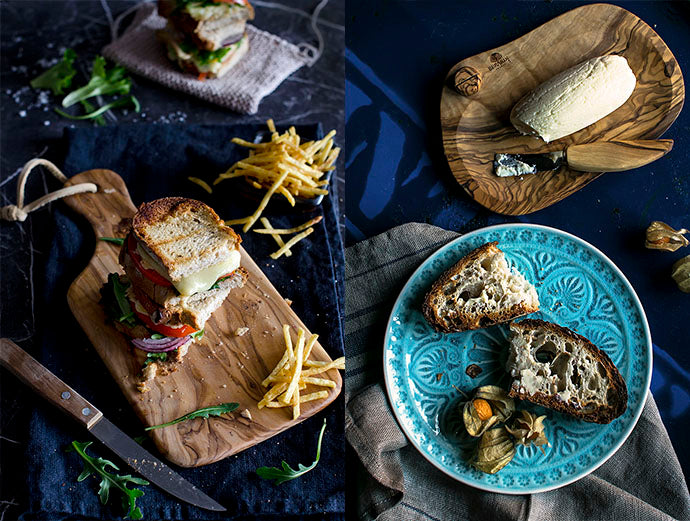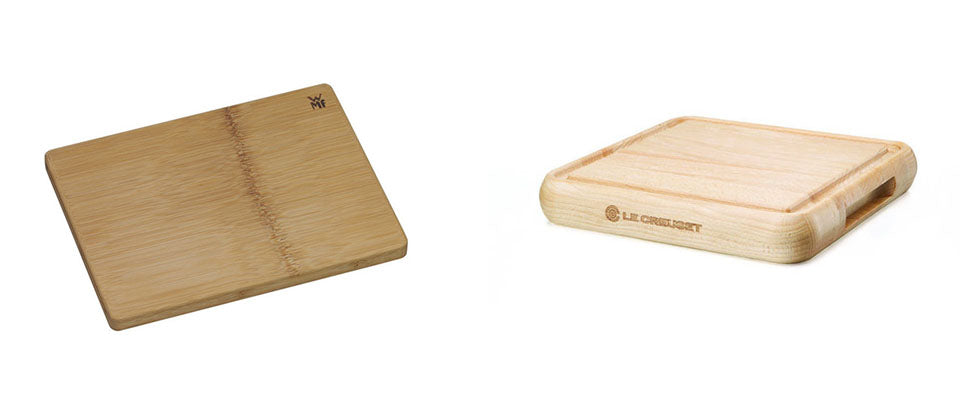It is important to choose a good cutting board for the kitchen, it is worth taking good care of the knives and also working on a surface that is comfortable for us. Today I would like to talk to you about some important concepts when choosing a board and how to take care of it correctly.
Types of cutting boards
The first thing that characterizes a board is the type of material it is made from.
Plastic or synthetic boards have become very popular as they usually do not damage knives and are easy to maintain. They are a good option although I personally prefer the charm of wooden boards.
Wooden boards, being a natural material, require a little maintenance and care in cleaning them, but they can be used in the kitchen or for serving, depending on the type of wood chosen.
Finally, there are boards made of other materials such as marble that are beautiful for serving but not suitable for cutting, obviously using a marble board is like cutting directly on the countertop (the worst for knives).
Types of wood for cutting boards
The type of wood on the cutting board will determine the best use you can give it: in the store we have bamboo, acacia, beech and olive wood boards.
I'll start with the last one: olive wood boards like those from Bérard are perfect for presenting on the table, since it is a really beautiful wood: its shapes, pattern and silky feel are characteristics that one falls in love with. It is a hard wood so it is not the most suitable for knives, but there is no problem in using it for cutting on the table (cold meats or cheese for example). It also has the advantage that the cuts are not as marked as with other woods so it will maintain its beautiful presentation for a long time.
As for the other boards we have in the shop, the acacia ones are a slightly softer wood. These are the boards from T&G , but they are also very well thought out as a board for cutting bread or presenting cold cuts or cheeses on the table. The truth is that T&G is a company that I find with a lot of character, and a rustic style that I adore. They have very nice boards, at a very good price, and the quality of their wood is indisputable. In the variety of their designs, I am sure that many of you will find a board that will catch your eye or that you will think is made for your kitchen.
Beech wood boards are the softest you will find in our store, and as I mentioned, that makes them ideal for cutting, since they will keep knives sharp for longer. The weak point, as many of you will have experienced on occasion, is that they are boards on which the cuts will be marked, which will make them somewhat uglier, but for that very reason they are recommended to keep in the kitchen, and not to present on the table. Of these, both the T&G and Le Creuset boards are practical, spacious and with a very good price-quality ratio.
There is another board, one that is very popular in our shop, the one from Rösle . It is made of beech but we can optionally buy synthetic slats to place on top, so you protect the wood from being cut -so you can use it perfectly for presentation- and because you can separate the types of food you cut on each slat (on one, vegetables, on another, fish, on a third, meat...). This is a board that we like a lot, because it is pretty, practical thanks to its non-slip legs, and comfortable since you can get different uses out of just one board.

Then there are bamboo cutting boards. Bamboo is a type of wood that is considered hard but at the same time it cushions very well, making it an ideal material for cutting. It has another advantage, and that is that bamboo has bacteriological properties, which makes them very suitable wooden cutting boards for use in the kitchen.
WMF bamboo board and Le Creuset beech board (both available in 26cm and 38cm sizes)
Cleaning and maintaining wooden cutting boards
It is important to properly clean wooden boards after use, otherwise bacteria will proliferate, which is not advisable when in contact with the food we are going to eat.
The boards should be washed with soap and water, on both sides. After washing, dry them well with a cloth - leaving them wet can encourage the growth of bacteria.
It is advisable to do a more thorough cleaning from time to time: just wipe half a lemon over the entire surface of the board. Its acidity will eliminate bacteria and odours. Leave it soaked in its juice for a few minutes, then wash it normally with soap and water.
In the case of olive wood boards, it is advisable to give them a layer of oil (you can do this by pouring a splash of oil on them and spreading it with a kitchen towel). Olive wood is an oily wood and rejuvenates with good hydration. This applies both to boards and other utensils such as spatulas and spoons.
You can also choose to apply Bérard's wood cleansing and moisturizing cream , which provides deep hydration and is a 100% natural cleanser.
If you can, leave the board standing vertically in the kitchen - it will ventilate, and that keeps the wood hygienic.
NOTE: If you are interested in seeing these tips and how to use the Bérard cream, I encourage you to watch the video that you will find here .
Which cutting board would you recommend?
It's hard to say which is the best choice or which is the best wood for a cutting board, as everyone has their own habits and preferences, but I recommend having a large cutting board in the kitchen. It's true that small boards take up much less space when storing them, but working on a large board is much more comfortable. Plus, the board doesn't have to be stored away. Doesn't it look lovely leaning against the wall or on the counter? Plus, it's better to have it close at hand, because you use it every day.
So, if we're talking about basics, my choice is a large (30cm upwards) beech or bamboo board for the kitchen (like the ones from T&G, Le Creuset or the bamboo one from WMF), and an olive or acacia wood board for serving at the table. In this case, I love having a small board, to present a cheese with a knife, or some cold cuts (the ones from Bérard are ideal for this purpose), and also having a large board, like the ones from T&G (many are large in size) or the ones from Kitchen Craft. They are beautiful and ideal for presenting a variety of cold cuts and some bread. Dinner is served!




























Comments
Elsa Solís Caballero said:
Las tablas de picar de Nambu son recomendadas para la salud, porque las de plástico y madera no recomienda
Sigrid said:
Gracias por la publicacion, nos ha aclarado muchas dudas y ahora sabemos que necesitamos minimo 2, una para la cocina y otra para servir en la mesa. Nos podriais comentar el uso que tienen las tablas de madera de mango? Visialmente son muy bonitas, recuerdan las formas del olivo. Que uso le podemos dar y si son aconsejable q?? Gracias
adrian said:
Genial el Post. Aclara muchas dudas. Yo compré hace años una tabla de corte de Hernández Vela y son brutales… Están hechas como se hacían antes, soy profesional y La uso a diario y la sigo teniendo nueva con un pequeño mantenimiento, se que tienen página web pero yo los localice por facebook. Os dejo el enlace
https://www.facebook.com/Tablashernandezvela/
Claudia&Julia said:
Hola Ana,
Disculpa el retraso en responder tu consulta, no hemos podido verlo hasta hoy.
Algunas tablas de cortar que no se mueven con el uso pueden ser la de bambú de Kuhn Rikon, la de Zwilling y también la de madera de haya de Rösle, dado que llevan pies antideslizantes.
Ahora mismo contactamos contigo para poder enviarte los enlaces.
Muchas gracias.
Ana said:
Hola , quiero comprarme una tabla de madera,la que tengo es sintética es bastante higienica pero no pesa nada, para cortar me gusta que no se mueva, cual me recomiendas?. Un saludo
Claudia said:
Muchas gracias!! me alegro que lo hayas encontrado interesante!
Manipulador de alimentos said:
Un articulo muy completo.Y preciosas fotos para explicar cada tabla-
Claudia said:
Hola Mercè, sin duda requerirías una tabla grande para cortar con comodidad, y que sea de cortar de haya o de bambú; una buena base es importante para tener seguridad. La que te recomendaría y que me encanta es la tabla grande de T&G. La encuentras aquí: http://bit.ly/1PGCJtE
Saludos, Claudia
Claudia said:
¡Me alegro mucho, Mireia! Muchas gracias y un saludo!
Mireia said:
Excelente explicación. Precisamente estaba pensando en adquirir una tabla y me habéis despejado todas las dudas. Sois los mejores!!
Mercè said:
Que tabla de madera necesitaria para cortar con el hacha pequeña por ejemplo el hueso del jamon i el pollo huesos fuertes etc…